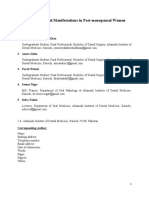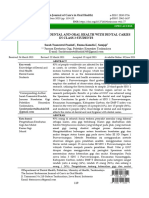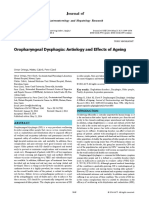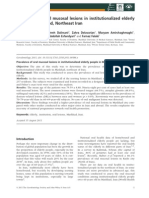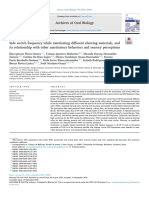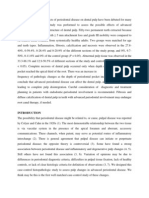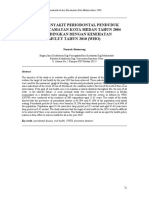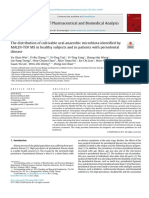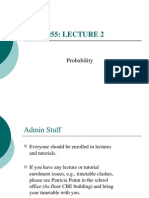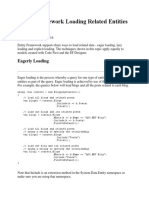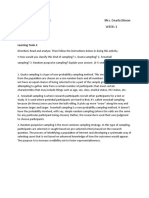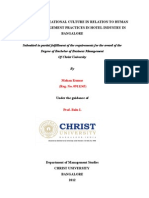ISSN 0975-8437 INTERNATIONAL JOURNAL OF DENTAL CLINICS 2011:3(1): 21-24
©I
NTERNATIONAL JOURNAL OF DENTAL
CLINICS
VOLUME
3
ISSUE
1J
AN
UARY-M
ARCH
2011 21
Oral Submucous Fibrosis: Correlation of Clinical Grading to various habit factors
Vanaja Reddy, P.V.Wanjari, Naveen Reddy Banda, Prashanti Reddy Abstract
Background: Over the past several decades, dental researchers reported different aspects of oral submucous Fibrosis (OSMF). Yet, there is a big lacunae in the present scenario of evidence based dentistry which correlates the role of critical components of a habit such as duration, frequency, chewing time to the clinical grading of OSMF. Aims: To correlate the etiological factors to the severity of clinical grading along duration, frequency and style of chewing habit. Materials and Methods: A cross sectional study of 390 oral submucous fibrosis (OSMF) patients who attended the dental clinic in Central India, Indore, over a period of 3 years was done. Results: Among cases, grade I OSMF was seen in 50.51% (197), grade II OSMF in 28.20% (110) and grade III OSMF in 21.28% (83) subjects, with a male to female ratio of 2.3:1. Gutkha and other arecanut products was practiced most commonly and showed significant risk in the severity of OSMF. Conclusion: The relative risk of OSMF increased with duration, frequency and style of chewing habits for longer duration and swallowing it without spitting.
Key words:
Oral Submucous Fibrosis;Arecanut;Gutkha. Received on: 21/07/2010 Accepted on: 13/10/2010
Introduction
Oral submucous fibrosis (OSMF) is a chronic, premalignant condition of the oral mucosa which was first described by Schwartz 1952.(1)
Pindborg (1966) defined OSMF as,
“an
insidious, chronic disease affecting any part of the oral cavity and sometimes the pharynx. Although occasionally preceded by and/or associated with vesicle formation, it is always associated with juxta-epithelial inflammatory reaction followed by fibroelastic change of the lamina propria, with epithelial atrophy leading to stiffness of the oral mucosa and causing trismus
and inability to eat”.
(2, 3) Worldwide, estimates of OSMF shows a confinement to Indians and Southeast Asians, with overall prevalence rate in India to be about 0.2% to 0.5 % and prevalence by gender varying from 0.2-2.3% in males and 1.2-4.57% in females.(4)
The age range of patients with OSMF is wide ranging between 20 and 40 years of age.(5) It has been suggested that ingestion of chillies, genetic susceptibility, nutritional deficiencies, altered salivary constituents, autoimmunity and collagen disorders may be involved in the pathogenesis of this condition.(3)
The condition is well recognized for its malignant potential rate of 7.6% and is particularly associated with use of areca nut in various forms with significant duration and frequency of chewing habits.(6, 7)
The alkaloids and flavonoids (arecoline, arecaidine, tannins and catechins) stimulate collagen synthesis and proliferation of fibroblasts and can act both as a chemical and physical irritant to oral mucosa. Furthermore, the micro trauma produced by the friction of coarse fibers of areca nut also facilitates the diffusion of betel quid alkaloids and flavonoids into sub epithelial connective tissue, resulting in juxta-epithelial inflammatory cell infiltration.(8)
Over the past several decades, dental researchers reported different aspects of OSMF. Yet, there is a big lacunae in the present scenario of evidence based dentistry which correlates the role of critical components of a habit such as duration, frequency, chewing time to the clinical grading of OSMF. The present retrospective study is being carried out to correlate these variables of the habit to the clinical grading of OSMF.
Materials and Methods
The present study was carried out in the department of Oral Medicine and Radiology, Modern Dental College and Research Centre, Indore, Madhya Pradesh. Clinical details were retrieved from the departmental files over a period of three years. After proper evaluation of the records, a total of 390 cases of clinically diagnosed OSMF were considered for the study. Clinical details included name, age, gender and different tissue abuse habits like, chewing panmasala with or without tobacco, gutkha chewing, areca nut chewing, plain tobacco, mawa, smoking, alcohol. Also duration of habit in years, frequency of habit per day, style of chewing i.e. spitting, swallowing and also duration taken to chew was recorded. Clinical
RESEARCH PAPER


ISSN 0975-8437 INTERNATIONAL JOURNAL OF DENTAL CLINICS 2011:3(1): 21-24
©I
NTERNATIONAL JOURNAL OF DENTAL
CLINICS
VOLUME
3
ISSUE
1J
AN
UARY-M
ARCH
2011 22
criteria for the diagnosis of OSMF were as per the criteria described by Bailoor DN (1993).(9) Grade 1 (Mild OSMF): Mild blanching, No restriction in mouth opening, Central incisor tip to tip of the same side, Normally in Males 5.03 cm. Females 4.5 cm, No restriction in tongue protrusion, mesio-incial angle of upper central incisor to the tip of the tongue when maximally extended with mouth wide open (Normally Males 6.73cm and Females 6.07cm), Cheek flexibility, CF= V1-V2. Two points measured between at one third the distance from the angle of the mouth on a line joining the tragus of the ear and the angle of the mouth, the subject is then asked to blow his cheeks fully and the distance measured between the two points marked on the cheek V1. CF =V1-V2. Mean value for males- 1.2 cm, females- 1.08 cm, burning sensation only on taking spicy food or hot temperature liquids, etc. Grade 2 (Moderate OSMF): Moderate to severe blanching, Mouth opening reduced by 33%, tongue protrusion reduced by 33%, flexibility also demonstrably decreased, burning sensation even in absence of stimuli, Palpable bands felt, Lymphadenopathy either unilateral or bilateral. Grade 3 (Severe OSMF): Burning sensation very severe, patient unable to do day to day work, more than 66% reduction in the mouth opening, cheek flexibility and tongue protrusion, in many the tongue may appear fixed, Ulcerative lesions may appear in cheek, thick palpable bands felt, lymphadenopathy is bilaterally evident. The data so gathered was sorted, tabulated and subjected to statistical analysis. R
esults
In the present study 390 OSMF subjects were screened, out of which 70.26% (274) were males and 29.74% (116) were females, and out of which grade I OSMF was seen in 50.51%(197), grade II OSMF in 28.20%(110), and grade III OSMF in 21.28%(83) subjects. The gender, the age group distribution for OSMF grading showed a non-significant variation, whereas the style of chewing, duration, frequency and time of chewing of the habit showed a significant variation of the clinical grading (Table 1). Table 1 Grade 1 OSMF Grade 2 OSMF Grade 3 OSMF P value Gender Male 135(49.3%) 77(28.1%) 62(22.6%) P = .586 Not Significant Female 62(53.4%) 33(28.4%) 21(18.1%) Age Group 20- 30 years 38(55.9%) 21(30.9%) 9(13.2%) P = .544 Not Significant 31 - 40 years 103(50.7%) 58(28.6%) 42(20.7%) 41 - 50 years 46(46.5%) 26(26.3%) 27(27.3%) more than 50 years 10(50.0%) 5(25.0%) 5(25.0%) The etiological factors of panmasala and smoking showed non-significance for gradation of OSMF, whereas arecanut, tobacco, mawa, and gutkha chewing showed significance. (Table 2) Table 2 Etiologic Factor Grade 1 OSMF N(%) Grade 2 OSMF N(%) Grade 3 OSMF N(%) Total (out of 390) P value Plain Pan Masala Use 14(53.8%) 8(30.8%) 4(15.4%) 26(6.67%) P = 0.748Not Significant Areca Nut Use 41(32.8%) 47(37.6%) 37(29.6%) 125(32.05%) P < 0.000Significant Tobacco Chewing 57(73.1%) 14(17.9%) 7(9.0%) 78(20.0%) P < 0.000Significant Mawa Use 19(86.4%) 2(9.1%) 1(4.5%) 22(5.64%) P = 0.002Significant Smoking 20(48.8%) 10(24.4%) 11(26.8%) 41(10.51%) P = .629Not significant Ghutka Use 61(40.1%) 42(27.6%) 49(32.2%) 152(38.97%) P < 0.000Significant
Plain pan masala (it contains areca nut, betel leaf, slaked lime, and catechu without tobacco).
Areca nut (only betel nut),
Mawa (it is a crude combination of areca nut, tobacco, and lime).
Gutkha (it is a mixture of dry areca nut, tobacco and other chemical in trace for flavoring).
ISSN 0975-8437 INTERNATIONAL JOURNAL OF DENTAL CLINICS 2011:3(1): 21-24
©I
NTERNATIONAL JOURNAL OF DENTAL
CLINICS
VOLUME
3
ISSUE
1J
AN
UARY-M
ARCH
2011 23
Table 3
S t y l e o f C h e w i n g
No Chewing 6(100.0%) 0(.0%) 0(.0%) P < 0.000 Significant Spitting 71(86.6%) 11(13.4%) 0(.0%) Swallowing 15(40.5%) 17(45.9%) 5(13.5%) Keeping in mouth and spitting 57(39.6%) 46(31.9%) 41(28.5%) Keeping in mouth and swallowing 48(39.7%) 36(29.8%) 37(30.6%)
D u r a t i o n G r o u p
upto 3 years 60(58.3%) 28(27.2%) 15(14.6%) P = 0.003 Significant 4-6 years 62(57.4%) 24(22.2%) 22(20.4%) 7-10 years 53(47.7%) 38(34.2%) 20(18.0%) 11-15 years 16(32.7%) 16(32.7%) 17(34.7%) > 15 years 6(31.6%) 4(21.1%) 9(47.4%)
F r e q u e n c y G r o u p
Upto 2 per day 31(93.9%) 0(.0%) 2(6.1%) P < 0.000 Significant 3-5 per day 66(62.3%) 33(31.1%) 7(6.6%) 6-10 per day 79(43.6%) 57(31.5%) 45(24.9%) 11-15 per day 15(27.8%) 17(31.5%) 22(40.7%) > 15 per day 6(37.5%) 3(18.8%) 7(43.8%)
C h e w i n g G r o u p
Upto 2 min 68(75.6%) 18(20.0%) 4(4.4%) P < 0.000 Significant 3-5 min 51(52.6%) 38(39.2%) 8(8.2%) 6-10 min 20(23.5%) 34(40.0%) 31(36.5%) >10 min 3(6.8%) 4(9.1%) 37(84.1%)
*chi square test
Discussion
Oral submucous fibrosis is a chronic debilitating disease of the oral cavity characterized by inflammation and progressive fibrosis of the submucosal tissues, well recognized for its malignant potential and is particularly associated with areca nut and tobacco chewing which is a habit practiced predominately in Southeast Asia and India that dates back for thousands years. The present study is undertaken to study the role of different variables which play a vital role in the clinical grading of OSMF in central India, Indore. Literature survey of gender distribution has shown wide variations in the occurrence of OSMF. Some epidemiological surveys in India have shown a female predominance.(7, 10)
In our study out of 390 OSMF study population we observed 70% (274) were males and 30% (116) were females, with a male to female ratio being 2.36:1, which was according to Chaturvedy et al in India.(11) We observed that half the study population was in the age group of third decade, which was in contrast to that of Ranganathan et al.(12)
The occurrence of OSMF according to age in our study was similar to that of studies done by Borle RM, Borle SR.(13) Male predominance in our study can be due to easy accessibility for males to use areca nut and its products more frequently than females in our society and changing lifestyles of the youngsters. Habitual chewing of gutkha and other areca nut products plays a major role in etiology of the condition. Out of 390 subjects, 6 subjects had no history of any of the etiological attributes of our study. This could be due to various hypotheses that have been put forward suggesting a multifactorial origin for this condition,(2, 8) other than the proposed
etiological factors in the study. In our study gutkha and other areca nut product users like mawa, tobacco when compared to plain panmasala users showed a significant occurrence of OSMF in the severity of the condition. The reason attributes to the fact that the commercially available products as above are concentrated, freeze dried and have higher dry weight concentration of pathology causing irritants in comparison(6,10,12)
to the traditionally prepared home made products like panmasala. Another factor supporting this could be the antioxidant capabilities of pan leaf which is known to be rich in beta-carotene, which has the capacity to quench free radicals that are mutagenic which counteracts the different pathology causing irritants.(14)Smoking consumption alone have been found to have no effect in development of OSMF, but their addition to areca nut using can be a risk factor for OSMF.(15)
In our study, as the duration of consuming habits increased above 10 years the severity of the disease also increased with maximum number of cases observed in grade II and grade III OSMF. The frequency of habit of consuming for more than 10 times per day resulted in increased severity of OSMF.
ISSN 0975-8437 INTERNATIONAL JOURNAL OF DENTAL CLINICS 2011:3(1): 21-24
©I
NTERNATIONAL JOURNAL OF DENTAL
CLINICS
VOLUME
3
ISSUE
1J
AN
UARY-M
ARCH
2011 24
Subjects, who consumed, less than 10 times per day had grade I and grade II OSMF. Style of chewing influenced the severity of the condition. The subjects who had the habit of chewing for longer time for more than 6 minutes and swallowing it without spitting has resulted in grade II and grade III severity. As the parameters of our study in the form of duration, frequency, style of chewing for longer time without spitting increased, it had a significant correlation with the outcome of the severity of the disease in the form of clinical grading. This is in accordance to literature which explains that arecanut has high alkaloid arecoline and tobacco ingredients like nitrosamine, which are absorbed more in the patients who keep it for longer durations and swallow it.(7, 16, 17)
Conclusion
The present study revealed the use of commercially available arecanut and tobacco byproducts to have shown a higher severity in terms of clinical grading. It was also found that as habit variables in the form of duration, frequency, and chewing for longer duration and swallowing without spitting have increased its significance in correlation to severity of clinical grading.
Authors Affiliations
: 1. Dr. Vanaja Reddy, M.D.S, Senior Lecturer, 2. Dr. P.V.Wanjari, M.D.S, Professor & Head, Department of Oral Medicine & Radiology, 3. Dr. Naveen Reddy.B, M.D.S, Senior Lecturer, Department of Pedodontics, 4. Dr. Prashanti Reddy, M.D.S, Senior Lecturer, Department of Oral Medicine & Radiology, Modern Dental College & Research Centre, Gandhinagar, India.
References
1.
Angadi PV, Rekha K. Oral submucous fibrosis: a clinicopathologic review of 205 cases in Indians. Oral and Maxillofacial Surgery2011;15(1):15-9. 2.
Pindborg J, Sirsat S. Oral submucous fibrosis. Oral Surgery, Oral Medicine, And Oral Pathology 1966;22(6):764. 3.
Rajendran R. Oral submucous fibrosis: etiology, pathogenesis, and future research. Bulletin of the World Health Organization1994;72(6):985-96. 4.
Phatak A. Fibrin producing factor in Oral Sub-Mucous Fibrosis. Indian Journal of Otolaryngology and Head & Neck Surgery 1979; 31(4):103-4. 5.
Rajendran R, Sugathan C, Remani P, Ankathil R, Vijayakumar T. Cell mediated and humoral immune responses in oral submucous fibrosis. Cancer1986;58(12):2628-31. 6.
Canniff J, Harvey W, Harris M. Oral submucous fibrosis: its pathogenesis and management. British Dental Journal1986;160(12):429-34. 7.
Sinor P, Gupta P, Murti P, Bhonsle R, Daftary D, Mehta F, Pindborg J. A case control study of oral submucous fibrosis with special reference to the etiologic role of areca nut. Journal of Oral Pathology & Medicine1990;19(2):94-8. 8.
Sirsat S, Khanolkar V. The effect of arecoline on the palatal and buccal mucosa of the Wistar rat. An optical and electron microscope study. Indian Journal of Medical Sciences1962;16:198-202. 9.
Gupta D, Gupta M, Golhar B. Oral submucous fibrosis; clinical study and management by physiofibrolysis. J Indian Dent Assoc1980; 52: 375-8. 10.
Murti P, Gupta P, Bhonsle R, Daftary D, Mehta F, Pindborg J. Effect on the incidence of oral submucous fibrosis of intervention in the areca nut chewing habit. Journal of Oral Pathology & Medicine1990;19(2):99-100. 11.
Chatuvedi V, Sharma A, Chakrabarati S. Salivary coagulopathy and humoral response in oral submucous fibrosis (OSMF). Journal of the Indian Dental Association1991;62(3):51-9. 12.
12. Ranganathan K, Devi MU, Joshua E, Kirankumar K, Saraswathi T. Oral submucous fibrosis: a case control study in Chennai, South India. Journal of Oral Pathology & Medicine 2004;33(5):274-7. 13.
Borle R, Borle S. Management of oral submucous fibrosis: a conservative approach. Journal of Oral and Maxillofacial Surgery1991; 49(8): 788-91. 14.
Stich H, Mathew B, Sankaranarayanan R, Nair MK. Remission of oral precancerous lesions of tobacco/areca nut chewers following administration of beta-carotene or vitamin A, and maintenance of the protective effect. Cancer Detection and Prevention1991;15(2):93-8. 15.
Shah N, Sharma P. Role of chewing and smoking habits in the etiology of oral submucous fibrosis (OSF): a case control study. Journal of Oral Pathology & Medicine1998;27(10):475-9. 16.
Tilakaratne W, Klinikowski M, Saku T, Peters T, Warnakulasuriya S. Oral submucous fibrosis: review on aetiology and pathogenesis. Oral Oncology2006;42(6):561-8. 17.
Avon SL. Oral mucosal lesions associated with use of quid. Journal-Canadian Dental Association 2004; 70(4):244-50.
Address for correspondence
Dr. Vanaja Reddy, M.D.S, Senior lecturer, Department of Oral Medicine and Radiology, Modern Dental College and Research Centre, Gandhinagar, Indore -453112, MP, INDIA. Email:
drvanreddy02@gmail.com
Source of Support: Nil, Conflict of Interest: None Declared











